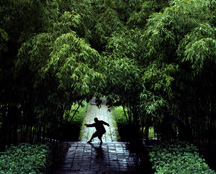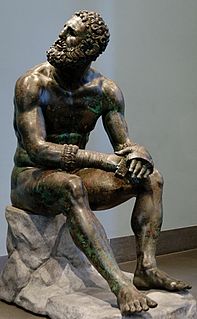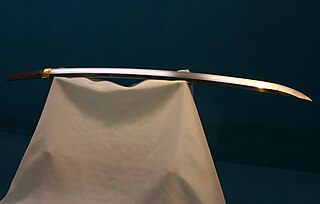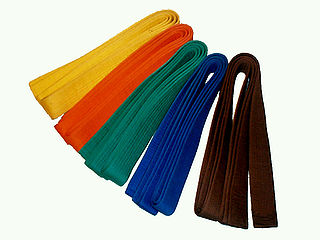
Neijia is a term in Chinese martial arts, grouping those styles that practice neijing, usually translated as internal martial arts, occupied with spiritual, mental or qi-related aspects, as opposed to an "external" approach focused on physiological aspects. The distinction dates to the 17th century, but its modern application is due to publications by Sun Lutang, dating to the period of 1915 to 1928. Neijing is developed by using neigong, or "internal exercises", as opposed to "external exercises".

A pole weapon or pole arm is a close combat weapon in which the main fighting part of the weapon is fitted to the end of a long shaft, typically of wood, thereby extending the user's effective range and striking power. Pole weapons are predominantly melee weapons, with a subclass of spear-like designs fit for both thrusting and throwing. Because many pole weapons were adapted from agricultural implements or other fairly abundant tools, and contained relatively little metal, they were cheap to make and readily available. When warfare would break out and the belligerents had a poorer class who could not pay for dedicated military weapons, leaders would often appropriate tools as cheap weapons. The cost of training was comparatively minimal, since these conscripted farmers had spent most of their lives using these "weapons" in the fields. This made polearms the favored weapon of peasant levies and peasant rebellions the world over.

The jian is a double-edged straight sword used during the last 2,500 years in China. The first Chinese sources that mention the jian date to the 7th century BCE, during the Spring and Autumn period; one of the earliest specimens being the Sword of Goujian. Historical one-handed versions have blades varying from 45 to 80 centimeters in length. The weight of an average sword of 70-centimetre (28-inch) blade-length would be in a range of approximately 700 to 900 grams. There are also larger two-handed versions used for training by many styles of Chinese martial arts.

Louis Cha Leung-yung, better known by his pen name Jin Yong, pronounced "Gum Yoong" in Cantonese, was a Chinese wuxia novelist and essayist who co-founded the Hong Kong daily newspaper Ming Pao in 1959 and served as its first editor-in-chief. He was Hong Kong's most famous writer, and is named along with Gu Long and Liang Yusheng as the "Three Legs of the Tripod of Wuxia".

Chinese martial arts, often called by the umbrella terms kung fu, kuoshu or wushu, are multiple fighting styles that have developed over the centuries in Greater China. These fighting styles are often classified according to common traits, identified as "families" of martial arts. Examples of such traits include Shaolinquan (少林拳) physical exercises involving All Other Animals (五形) mimicry or training methods inspired by Old Chinese philosophies, religions and legends. Styles that focus on qi manipulation are called internal, while others that concentrate on improving muscle and cardiovascular fitness are called external. Geographical association, as in northern and southern, is another popular classification method.
Bow-sim Mark is a martial arts grandmaster who lives in Newton, Massachusetts, US. She is the mother of martial arts film star, Donnie Yen.

The butterfly sword is a short dao, or single-edged sword, originally from southern China, though it has also seen use in the north. It is thought that butterfly swords date from the early 19th century. Several English language accounts from the 1840s describe local militia in Guangdong being trained in the "double swords", short swords with a hook extending from the guard, and fitting into a single scabbard.

Mustafa Kemal "Muzzy" Izzet is a former professional footballer who played for Chelsea, Leicester City, Birmingham City and the Turkey national team as a midfielder.
Angela Mao Ying is a Taiwanese actress and martial artist who appeared in martial arts films in the 1970s. One of the most prominent martial artist actresses of her time, she is nicknamed "Lady Whirlwind" and "Lady Kung Fu". She was positioned as a female version of Bruce Lee.

In martial arts, a knifehand strike is a strike using the part of the hand opposite the thumb, familiar to many people as a karate chop. This refers to strikes performed with the side of the knuckle of the small finger. Suitable targets for the knifehand strike include the mastoid muscles of the neck, the jugular, the throat, the collar bones, ribs, sides of the head, temple, jaw, the third vertebra, the upper arm, the wrist, the elbow, and the knee cap.

Mok Gar (莫家) is one of the five major family styles of Southern Chinese martial arts. It was developed by a Shaolin monk named Monk Mok Ta Shi (莫達士) as an inheritance of the Southern Shaolin Fist in Guangdong province in China.

Although the earliest evidence of martial arts goes back millennia, the true roots are difficult to reconstruct. Inherent patterns of human aggression which inspire practice of mock combat and optimization of serious close combat as cultural universals are doubtlessly inherited from the pre-human stage and were made into an "art" from the earliest emergence of that concept. Indeed, many universals of martial art are fixed by the specifics of human physiology and not dependent on a specific tradition or era.

A katana is a Japanese sword characterized by a curved, single-edged blade with a circular or squared guard and long grip to accommodate two hands. Developed later than the tachi, it was used by samurai in feudal Japan and worn with the edge facing upward. Since the Muromachi period, many old tachi were cut from the root and shortened, and the blade at the root was crushed and converted into katana. The official term for katana in Japan is uchigatana (打刀) and the term katana (刀) often refers to single-edged swords from around the world.
The Muyesinbo is a Korean martial arts manual published in 1759. The book is a revision of the older Muyejebo, made during the reign of King Youngjo (1724–1776). It adds twelve disciplines or "skills" of both armed and unarmed fighting by Prince Sado to the original six which were descbribed in the Muyejebo. No copies of the Muyesinbo have survived, but its contents can easily be determined by tracing back and comparing the Muyejebo with the later Muyedobotongji.
Liuxing Hudie Jian is a wuxia novel by Gu Long. It was first published in Taiwan in August 1973 by Laureate (桂冠) and subsequently reproduced by other publishing companies. It has been adapted into the 1976 film Killer Clans, a 1978 television series produced by Hong Kong's CTS, the 1993 film Butterfly and Sword, a 2003 mainland Chinese television series, and a franchise of video games.

Many Japanese martial arts feature an obi as part of their exercise outfit. Such an obi is often made of thick cotton and is about 5 cm wide. The martial arts obi are most often worn in the koma-musubi knot ; in practice where a hakama is worn, the obi is tied in other ways.
Wudang Sword is a body of Chinese straight sword (jian) techniques—famous in China—encompassed by the Wudang quan or internal martial arts.

Wudang quan is a class of Chinese martial arts. In contemporary China, Chinese martial arts styles are generally classified into two major groups: Wudang (Wutang), named after the Wudang Mountains; and Shaolin, named after the Shaolin Monastery. Whereas Shaolin includes many martial art styles, Wudangquan includes only a few arts that use the focused mind to control the body. This typically encompasses taijiquan, xingyiquan and baguazhang, but must also include Baji chuan and Wudang Sword. Although the name Wudang simply distinguishes the skills, theories and applications of the internal arts from those of the Shaolin styles, it misleadingly suggests these arts originated at the Wudang Mountains. The name Wudang comes from a popular Chinese legend that incorrectly purports the genesis of taijiquan and Wudang Sword by an immortal, Taoist hermit named Zhang Sanfeng who lived in the monasteries of Wudang Mountain.
"The Legend of the Double Dragon of the Tang Dynasty " is a Wuxia novel written by Huang Yi based on the background of the end of the Sui Dynasty and the beginning of the Tang Dynasty, which integrates history, military, and fantasy, The full set of books totals more than 5 million words. It has been adapted into TV dramas and comics. And games etc. Its continuation is " Sun and Moon in the Sky ".










